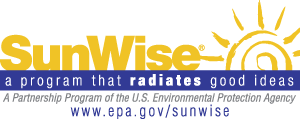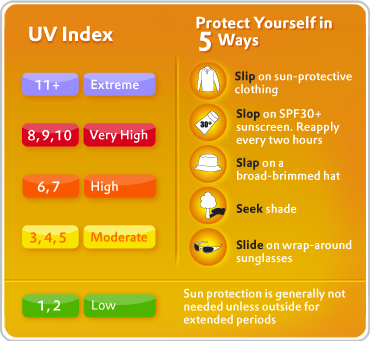 |
Do Not
Burn
Five or more sunburns doubles your risk of developing skin
cancer. |
|

|
Avoid
Sun Tanning and Tanning Beds
UV light from tanning beds and the sun causes skin cancer and
wrinkling. If you want to look like you’ve been in the sun,
consider using a sunless self-tanning product, but continue to
use sunscreen with it. |
 |
Generously Apply Sunscreen
Generously apply sunscreen to all exposed skin using a Sun
Protection Factor (SPF) of at least 15 that provides
broad-spectrum protection from both ultraviolet A (UVA) and
ultraviolet B (UVB) rays. Reapply every two hours, even on
cloudy days, and after swimming or sweating. |
 |
Wear Protective Clothing
Wear protective clothing, such as a long-sleeved shirt, pants,
a wide-brimmed hat, and sunglasses, where possible. |
 |
Seek
Shade
Seek shade when appropriate remembering that the sun’s UV rays
are strongest between 10 a.m. and 4 p.m. Remember the shadow
rule when in the sun: Watch Your Shadow. No Shadow, Seek Shade! |
 |
Use
Extra Caution Near Water, Snow and Sand
Water, snow and sand reflect the damaging rays of the sun,
which can increase your chance of sunburn. |
 |
Watch
for the UV Index
The UV Index provides important information to help you plan
your outdoor activities in ways that prevent overexposure to the
sun. Developed by the National Weather Service (NWS) and EPA,
the UV Index is issued daily in selected cities across the
United States. |
 |
Get
Vitamin D Safely
Get vitamin D safely through a diet that includes vitamin
supplements and foods fortified with Vitamin D. Don’t seek the
sun. |

http://www.epa.gov/sunwise/index.html
Early
detection of melanoma can save your life. Carefully examine ALL
of your skin once a month. A new or changing mole in an adult should
be evaluated by a dermatologist.
Credit:
EPA Sunwise Program
|
Energy from the sun reaches the earth as visible, infrared, and ultraviolet rays
- ultraviolet C (UVC)
wavelengths are 100 to 280 nm
Only UVA and UVB ultraviolet rays
reach the earth's surface. The earth's atmosphere absorbs UVC wavelengths.
- UVB rays cause a much greater
risk of skin cancer than UVA.
- However, UVA rays cause aging,
wrinkling, and loss of elasticity.
- UVA also increases the
damaging effects of UVB, including skin cancer and cataracts.
Credit:WMO,EPA
|













